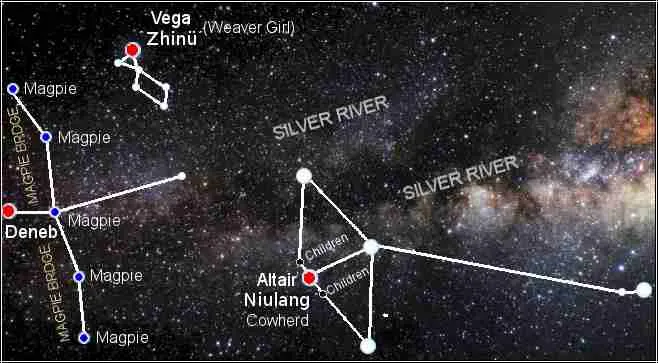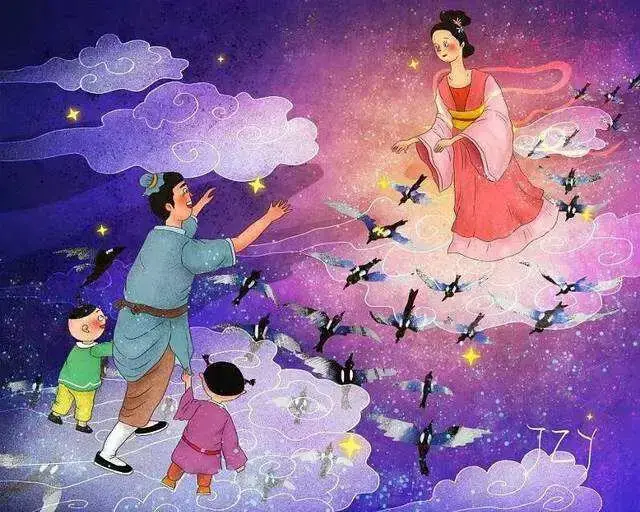The legend of the Cowherd and the Weaver Girl is one of the best-known love stories in Chinese mythology. This tale has been told for centuries and has become deeply ingrained in Chinese tradition. This article will delve into the whole narrative of “The Cowherd and the Weaver Girl,” its author, the history of Cowherd and Weaver Girl Day, and the moral of the story.
the cowherd and the weaver girl full story

First written more than 2,600 years ago in ancient China, “The Cowherd and the Weaver Girl” is a classic tale of young love. Story of Niu Lang, a young cowherd, and Zhinü, a beautiful fairy also known as the Weaver Girl. Poems, songs, and even operas have been written about them and their love story has come to play a significant role in Chinese culture.
A young cowherd named Niu Lang once lived in the countryside with his cattle. While out with his oxen one day, he encountered seven fairy sisters who had come down from heaven to swim in a local lake. The youngest and most attractive of the sisters, Zhinü, attracted Niu Lang. She captivated him with her attractiveness, and he quickly fell in love with her.
Zhinü, like Niu Lang, had an immediate and strong attraction to her, and the two quickly began spending time together and eventually fell in love. But the Emperor of Heaven soon found out about their relationship and banned Zhinü to see Niu Lang again. Niu Lang was left devastated after she was sent back to heaven.
Niu Lang’s goal was to reunite with Zhinü, so he spared a magical cow from the slaughterhouse and asked it for help. Niu Lang was informed by the cow that he could use its hide to reach the heavens and locate Zhinü. After hearing the cow’s advice, Niu Lang tracked down Zhinü in the afterlife.
The Emperor of Heaven, however, remained unconvinced and ordered the couple’s permanent separation. He physically separated them by inserting the Milky Way between them. On the seventh day of the seventh lunar month, magpies built a bridge over the Milky Way so the two lovers could finally be together. The Qixi Festival, also known as Cowherd and Weaver Girl Day, is celebrated annually on this day.
Niu Lang and Zhinü persisted through all of their difficulties and eventually found a way to be together. This tale tells us that love is strong enough to triumph over adversity, and that with hard work and dedication, we can do anything. It serves as a timely reminder that there are no barriers to love, not even geography.
Cowherd and Weaver Girl Day is a special day for couples to celebrate their love and commitment to one another in Chinese culture. Zhinü, the Weaver Girl, is worshipped in the hopes of finding romantic success. In addition, many pairs choose to commemorate their love with gifts and dates.
The Author of the Cowherd and the Weaver Girl
It is unknown for definite when the story of the Cowherd and the Weaver Girl first appeared, but it is widely assumed to have been written down during the Han Dynasty (206 BCE-220 CE). Poems, songs, and even operas were all inspired by the story, which has since become an integral part of Chinese culture thanks to its long and storied history of oral transmission.
what is cowherd and weaver girl day
when did the cowherd and weaver girl meet?
Cowherd and Weaver Girl Day, or Qixi Festival, is a traditional Chinese holiday observed on the seventh day of the seventh lunar month. Being the Chinese equivalent of Valentine’s Day, this is a special day for couples to show their affection for one another.
The ancient Chinese love story about a cowherd named Niu Lang and a weaver girl named Zhinü is the inspiration for Cowherd and Weaver Girl Day. Poems, songs, and even operas have all drawn inspiration from the story, making it an essential element of Chinese culture.
Zhinü, the Weaver Girl, is the object of worship on this day, and gifts are given to her in exchange for prayers for success in love and marriage. Some couples also go on romantic dates or give each other gifts like flowers or chocolate to show their appreciation for each other.
Creating Chinese Valentine’s Day wishes is a common activity on Cowherd and Weaver Girl Day. Historically speaking, wives wished for a nice spouse, while husbands wished for a beautiful and good woman to share their lives with. Even in modern times, couples continue to take part in this tradition by making wishes for their love and future together.
the cowherd and the weaver girl moral lesson
The Cowherd and the Weaver Girl is a classic Chinese love story that teaches us a valuable moral lesson about the power of true love and perseverance.
The story shows us that love can conquer all obstacles, no matter how great they may seem. Niu Lang and Zhinü faced many challenges, including social class and distance, and were even separated by the Emperor of Heaven himself. However, they never gave up on their love for each other and found a way to be together.
The story also teaches us that true love is not bound by social class, status, or even distance. Niu Lang was just a poor cowherd, while Zhinü was a fairy from heaven. Despite this, they fell deeply in love with each other and proved that love knows no boundaries.
Furthermore, the story encourages us to have determination and perseverance in the face of adversity. Niu Lang was determined to be with Zhinü and sought the help of a magical cow to travel to heaven and find her. His determination and perseverance paid off, and he was able to find Zhinü and be with her.
what year did the cowherd and weaver girl
The legend of the Cowherd and the Weaver Girl likely originated in China some time before or during the Han dynasty (206 BC – 220 AD). The tale has endured the test of time, becoming an integral part of Chinese tradition.
A poem from the Classic of Poetry, a compilation of ancient Chinese poetry produced in the 11th century BC, contains the earliest known written account of the story. The cowherd in “The Cowherd” falls in love with a weaving girl, but he and she can’t be together because of their different professions.
The tale changed and morphed through the ages, spawning several plays, operas, and folk songs. A account of the story can be found in a book titled “Eternal Questions for the Tang Emperor,” written during the Tang dynasty (618-907 AD).
The drama “The Peony Pavilion” by Tang Xianzu was published during the Ming era (1368-1644 AD), when the story was at the height of its fame. Romantic drama with a subplot based on the legend of the Cowherd and the Weaver Girl.
Even now, on the seventh day of the seventh lunar month, which is known as Cowherd and Weaver Girl Day, the tale is remembered and honoured throughout China. The day, also called Qixi Festival, celebrates the eternal love story of Niu Lang and Zhinü and is a time for lovers to declare their devotion to one another.
the cowherd and the weaver girl stars

Constellations in the night sky symbolise the Cowherd and the Weaver Girl from Chinese mythology. These stars form the Northern Hemisphere constellation Qi Xi (), sometimes known as the “Seven Sisters,” and can be seen during the summer months.
Star “Niulang” () in the constellation Aquila, the Eagle, represents the Cowherd. Lyra, also nicknamed the Harp for its constellation shape, contains the star “Zhinü” (), which is thought to depict the Weaver Girl.
The Milky Way symbolises the Heavenly River that separated the Cowherd and the Weaver Maid in mythology. A bridge of magpies would form across the Heavenly River and rejoin the Cowherd and the Weaver Girl for one night each year on the seventh day of the seventh lunar month.
Cowherd and Weaver Girl Day, or Qixi Festival, is celebrated in China on March 14. The eternal love story of Niu Lang and Zhinü serves as inspiration for this day dedicated to lovers.
Many still look to the Cowherd and the Weaver Girl’s stars as a source of motivation and a reminder of the value of loving and appreciating those who are close to us.
magpie bridge meaning

In the Chinese folktale of the Cowherd and the Weaver Girl, a symbolic bridge known as the Magpie Bridge plays an important role. The Milky Way stands in for the Heavenly River, which separated the Cowherd and the Weaver Girl in the myth. The Cowherd and the Weaver Girl were separated from one other for the majority of the year, but once a year, on the seventh day of the seventh lunar month, a bridge made of magpies would develop across the Heavenly River, allowing them to be together once more.
The Magpie Bridge represents everlasting affection and the strength of human bonds. Because of their association with pleasure and good fortune, magpies hold a special place in Chinese tradition. In light of this happy outcome, the construction of the Magpie Bridge is cause for much rejoicing and celebration. The Cowherd and the Weaver Girl had been separated for an entire year.
The Magpie Bridge is a symbol for the value of perseverance in maintaining connections with those you care about. There was a big distance between the Cowherd and the Weaver Girl, but their love was strong enough to overcome it. The day the Magpie Bridge was formed, the seventh of the seventh lunar month, serves as a reminder that any challenge may be met head-on with enough care and resolve.
The Magpie Bridge is still widely used as a metaphor for everlasting love and the strength of human bonds in modern China. The Cowherd and the Weaver Girl’s tale, as well as the Magpie Bridge they built, is a timeless reminder of the value of family and the need of working through difficulties to keep the people we care about close.
Conclusion
The Cowherd and the Weaver Girl is a timeless love story that has captured the hearts of generations of Chinese people. It has inspired countless works of art and literature and continues to be celebrated today on Cowherd and Weaver Girl Day. This story reminds us of the power of love and the importance of never